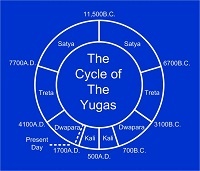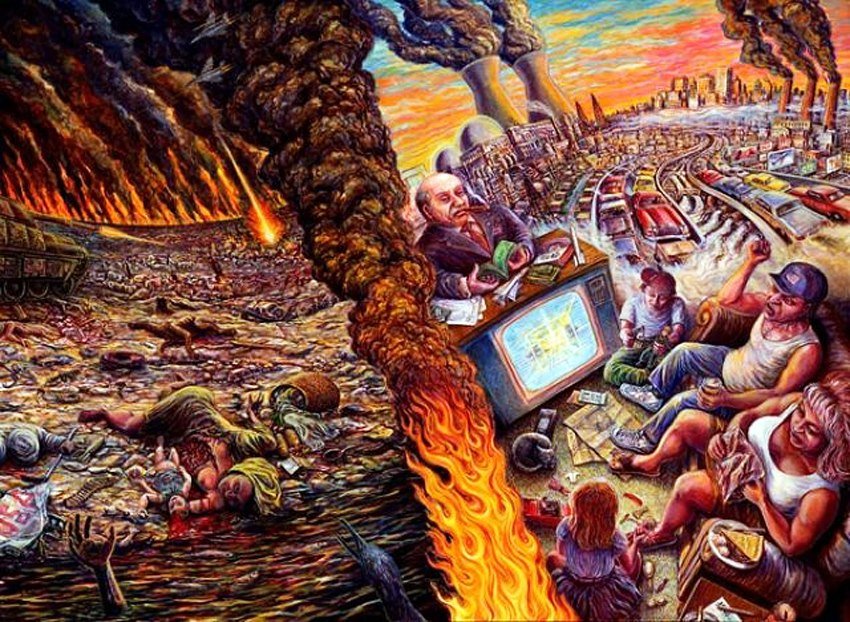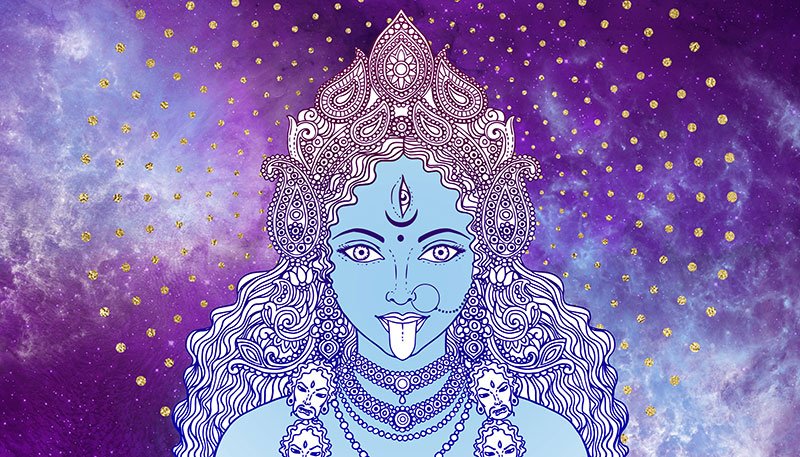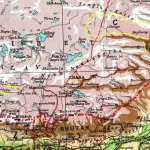kɑːli ˈyʊg ə – कलियुग
A 2,400-year age of darkness. The recent ascending Kali Yuga lasted 1,200 years from 500 and 1700 AD. (1) Sri Yukteswar in The Holy Science described Kali Yuga as an age during which consciousness was limited to gross matter. (2)
During Kali Yuga, most people lost their spiritual abilities, mental clarity, and understanding. (3) The age was characterized by the belief that matter was fixed and absolute. For example, religious truths were only accepted as absolute definitions or dogma, and science presented the universe as a mechanism; the divine realms were imagined as static, instead of dynamic. (4)
Within the physical realm, Kali Yuga people exhibited ingenuity and skill in engineering. By applying man power and animal power to building materials with an understanding of physical laws, people around the world were able to construct roads, temples, cathedrals, and buildings. Even civilizations far apart from each other has access to similar knowledge and resources. (2)
During Kali Yuga, most people functioned in low consciousness. But higher knowledge existed in monasteries, temples, and ashrams, where people directed themselves toward inward spiritual practice. Other high-minded artists and philosophers during the age were able to attain beauty, moral understanding, and consciousness through their works.
References
- Autobiography of a Yogi, by Paramhansa Yogananda. p. 167.
- The Yugas, by David Steinmetz and Joseph Selbie. Chapter 2, “The Kali Yugas”
- The Essence of the Bhagavad Gita, explained by Paramhansa Yogananda. pp. 175-176.
- Religion in the New Age, by Swami Kriyananda. Chapter 3, “What Is Happening to Our Planet?”

1. What is Kali Yuga?
“The ancients understood time as a circle, not linear, and the circle of ages are known as the yugas. Like the four seasons in our year, there are four yugas in the full cycle (Mahayuga). Each cycle has distinct themes and spiritual lessons for humanity. Below are the four yugas in order from beginning to end. It is important to note that the first yuga is the longest with each one getting successively shorter (4:3:2:1) until the cycle starts again.
The ancients understood time as a circle.
- Satya Yuga: First we see the time of truth and perfection, which thankfully lasts four tenths of the cycle. These humans are honest, youthful, vigorous, and virtuous. Everyone is happy, and religions live as one. Disease in non-existent, as is fear. Those living through this part of the cycle are gifted with abundance through the land, along with great weather.
- Treta Yuga: The second Yuga lasts for three tenths of the cycle. Unfortunately, this is where human virtue begins to fall away. Leaders gain more dominance, causing wars to rise. As if to reflect the state of humanity, the weather also moves to more extremes. It is unsurprising that people’s health begins to lessen in this part of the cycle.
- Dvapara Yuga:The third Yuga lasts for two tenths of the cycle. During this time, people become more sluggish and slow, many aren’t as strong as their ancestors, and the number of diseases increases. Becoming discontent with their lives, humans fight each other. This could possibly be because maturity decreases, with some people still possessing characteristics of youth in old age.
- Kali Yuga:The final age lasts only one tenth of the cycle, however, that is certainly long enough as it is the age of darkness and ignorance. People slide further down the path of dishonesty, with virtue being of little value. Passions become uncontrollable as unrestrained sexual indulgences and manipulations run through society. Liars and hypocrites rise. Important knowledge is lost and scriptures become less and less common. The human diet is now ‘dirty’, and people are not even close to being as powerful as their ancestors in the Satya Yuga. Likewise, the once pristine environment is now polluted. Water and food become scarce, as do family bonds.

2. Karma
“Karma is the Hindu view of causality in which good deeds, words, thoughts, and commands lead to beneficial effects for a person, and bad deeds, words, thoughts, and commands lead to harmful effects. These effects are not necessarily immediate but can be visited upon a soul in future lives through reincarnation; additionally, good or bad fortune experienced in life may be the result of good or bad actions performed in a past life.
One’s karmic state affects the reincarnation of the soul: good karma may lead to reincarnation as a human while bad karma can lead to reincarnation as an animal or other forms of non-human life. Many Hindus hold a theistic view of karma in which a personal god—such as Vishnu in Vaishnavism and Shiva in Shaivism—is responsible for administering karma according to a soul’s actions. Non-theistic strands of Hinduism believe that karma is a matter of basic cause-and-effect without the need of a deity to mediate the effects.
Karma is a core concept in the Indian religions, including Buddhism, Jainism, and Sikhism, although their specific views on karma vary. In Hinduism, karma is the force of retributive justice that compels believers to behave righteously according to Dharma—the moral order of the universe. As such, karma is a central component of the Hindu ethical worldview.
Further, because Hindu religious ordinances govern not just the individual believer but society as a whole, belief in karma enforces and perpetuates systems of social organization prescribed in Hindu scriptures. Karma also bolsters active worship on the part of believers, as many Hindus hold that bad karma can be counteracted through ritual activity including religious pilgrimages, temple worship, and making offerings to the gods.”

3. When is the Kali Yuga ending?
The method I found to be the most accurate involves sourcing information from the famed Indian astronomer Aryabhata, who sourced his information from the oldest Vedic texts, including ones now lost to us. Accounting for deliberate obfuscations of the truth by people who came after him, I have uncovered that Aryabhata wanted us to know that the entire yuga cycle is 24,000 years old.
This means that there is a 12,000-year ascent from Kali Yuga to Satya Yuga, followed by a 12,000-year descent, from Satya Yuga to Kali Yuga. In the video, I go into all of the parallels in other civilizations in the ancient world that also match the complete 24,000 year cycle.
You can view this time cycle as being a sine wave. Considering that “as above, so below” holds true universally, it makes sense that time is line a sine wave. However, mapping it our multidimensionally, we can view time as being a spiral. This matches the way the planets move around the sun, kind of like this:
Aryabhata found that the highly advanced beings that brought wisdom and knowledge to his civilization taught about each yuga being equal, not following the 4:3:2:1 count that crept in far more recently, muddying the waters. This means that each yuga is 3,000 years long, which includes a 300-year transition period between yugas where there is a blend of both the yuga prior and the yuga post the transition period. I go into great depth in the first video in this article showing the vast archeological, geological, and cultural evidence that a majority of the most tumultuous times on Earth and in society occurred within these 300-year transition periods.
…and that leads us to today.
We are currently in the ascending Kali Yuga, which started in 676 BCE. This means the ascending Kali Yuga will end in 2025 CE!
Here’s a handy chart that shows the dates of the start and end of every ascending and descending yuga within the macro yuga cycle we are in.

Following 2025, we will have a turbulent 300-year transition period before we fully enter the ascending Dwapara Yuga. Let’s face it; we didn’t come to Earth at this time for a vacation. We are here during this Time of Transition to help humanity ascending in consciousness and tilt its evolution towards a positive future present.
Source:
1. https://www.ananda.org/yogapedia/kali-yuga/
2. by Jacob Devaney on Tuesday November 1st, 2016 – https://hippiekushiwakinguptolife.com/the-kali-yuga
3. by Shift – https://www.shift.is/2021/06/the-yuga-cycle-when-does-the-kali-yuga-end/











